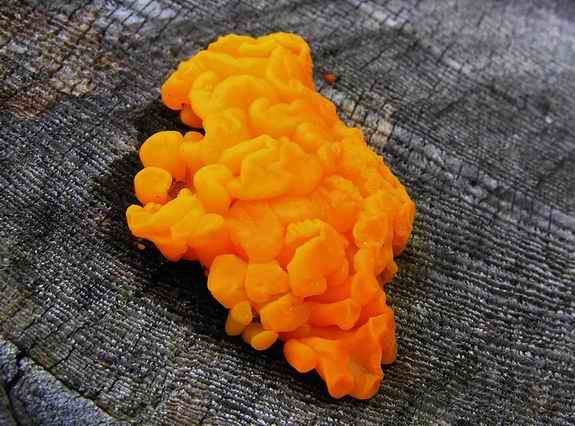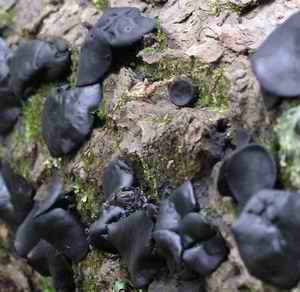|
Return to Hiker's Notebook Home Page
Common Name: Witches' Butter, Yellow brain fungus, Golden jelly fungus, Tripe fungus, Tremelle jaune (French), Huang jin yin er (Chinese), Hida kikurage (Japanese), gullkr�s (Swedish), Viltig judasoor (Dutch) - the color and rippled structure of the fungus have the appearance of butter; its sylvan habitat and random distribution suggest a supernatural origin, the witch being the choice born of superstition.
Scientific Name: Tremella mesenterica - the generic name is from the Latin tremere which is the verb "to tremble" referring to the jelly-like consistency of the fungus. The specific name is a combination of the Greek mesos, meaning "middle" and the prefix entero meaning "intestine."
The mysterious emergence of fungi at incongruous locations contributes to the etiology of their provenance; the name Witches' Butter suggests that T. mesenterica is a witch's version of the dairy spread. Conversely, it may be so named to suggest that it was deliberately deposited by a witch to cast an evil spell. The latter version is the more likely, as various folk legends of Eastern Europe associate Witches' Butter with the hex of a witch; according to this superstition, the only way to remove the spell was to pierce the gelatinous talisman with holes to drain the fluid to dehydrate and consequently extirpate it. This would likely have little effect, as the fungus is capable of rehydration during moist weather conditions, which would then restore the spell. The British have a more sinister view; the excrescences of the English woodlands called Witches' Butter are black in color. It is, however, altogether a different species. The scientific name is Exidia glandulosa and it is listed either as Black Witches' Butter or as Black Jelly Roll depending on the reference. Mushroom guides generally list its edibility as "of no culinary interest." In the seminal book Mushrooms Demystified, David Aurora characterizes its edibility as "unknown, and like myself, likely to remain so."
Witches' butter, on the other hand, is considered edible. However, the scientific name that translates as "trembling intestine" and the infrequent colloquial name "tripe fungus" do not contribute to this consideration. Unlike most other edible fungi, jelly fungi are generally not consumed in isolation, but rather are added to soups as a means to add texture; the Wood Ear (Auricularia auricula) is commonly used in Asian recipes to this end. Tremelloid fungi have long been considered a luxury food item in both China and Japan, the most notable being T. fuciformis. Known as the yin er meaning "silver ear" in Chinese and shiro kikurage meaning "white tree jellyfish" in Japanese, it has little taste but a texture that is described by the noted mycologist Tom Volk as "soft but crunchy at the same time." It is most commonly called snow fungus in English since the fruiting bodies look somewhat like snowballs. The traditional way of preparing it is as a desert after boiling followed by a twelve hours soaking in a sugar solution.
Jelly fungi have been used for medicinal purposes in Asia for millennia as a means to improve breathing and circulation; extended longevity is widely attributed to the consumption of tremelloid fungi over a long period of time. Investigation of the medicinal benefits of the jelly fungi in general and T. fuciformis in particular has revealed that they stimulate the immune system, reduce inflammation, lower cholesterol and are useful in the treatment of allergies and diabetes. A group of Israeli and Ukrainian researchers evaluated fungi of the Tremella genus in 2000 and confirmed that they exhibited antitumor properties and that they could be used to "improve immunodeficiency � and to prevent senile degeneration of microvessels." They attributed these effects to the presence of long chain sugars called polysaccharides, notably the acidic heteropolysacharide glucoronoxylomannan.
Jelly fungi are basidiomycetes. Like the gilled mushrooms, their spores are located at the end of a basidia that extend from the surface of the gelatinous fruiting body. The basidia of the tremelloid fungi differ from other genera in that they are septate or cruciate septate; they are divided by septa that separate in maturity to form four spore-bearing sterigmata. Witches' Butter deceptively appears to grow on a wood substrate. However, the fungus is parasitic on other wood decay fungi, particularly those of the genus Stereum, members of the Parchment fungus family. They appear to be growing on wood substrate because the mycelium of the host fungus on which they subsist grows inside the wood and is consequently not visible. |

